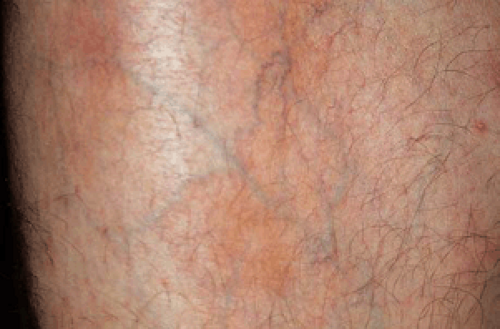Proper Use of Topical Corticosteroids
Andrew J. Scheman
Warning
It is unusual to begin a pharmacology or formulary section with a warning. Warnings are generally reserved for the end. But because topical corticosteroids often cause serious local side effects when used improperly and because prescriptions are sometimes given in a cavalier manner, it is worth describing pitfalls at the outset.
Local side effects of steroid use can be permanent, disfiguring, and very distressing. Skin atrophied from topical corticosteroids appears thin, transparent, shiny, hypopigmented, and telangiectatic (Fig. 1-1). Striae may develop. These changes are especially noticeable and distressing on the face. Other high-risk areas prone to steroid atrophy are intertriginous areas, such as the groin, axillae, neck, and intergluteal cleft.
It is worth remembering that topical corticosteroids may cause the same systemic side effects as oral corticosteroids. This is especially true in children, in whom the high ratio of skin surface area to body weight makes treatment of even relatively small areas of the skin more problematic.
 Figure 1-1 Atrophy from topical corticosteroids presents as thin, hypopigmented, telangiectatic skin. |
Patients—or their family members—often use whatever cream is in the medicine cabinet. It is not unusual for a patient with acne to use a super-potent topical corticosteroid on the cheek or nose, believing that “one cream is just as good as another.” Therefore, it is wise to prescribe only the amount that the patient needs immediately and to limit refills.
Although it sounds simplistic, patients on potent topical medications need follow-up no less than patients taking oral medications. Proper and timely adjustments of therapy to less (or more) potent preparations hastens relief from skin disease and limits the potential for untoward effects.
Avoiding Topical Corticosteroid Side Effects in High-risk Areas
Unfortunately, we all encounter instances in which a dermatitis on the face, groin, axillae, or intergluteal folds, or on a child, does not respond to lowest-potent agents. As will be discussed, low- or medium-potent topical corticosteroids that are nonfluorinated can be effective in this situation; desonide 0.05%, and, if a more potent agent is needed, hydrocortisone valerate 0.2%, are good choices. Occasionally, an even stronger preparation is needed. Mometasone furoate 0.1% ointment is the only high-potent topical corticosteroid ointment that is nonfluorinated. Caution is still in order, however. Although the use of nonfluorinated topical corticosteroids reduces the likelihood of side effects, it does not eliminate them.
Topical Corticosteroids are Grouped by Strength
The list of topical corticosteroids has many chemical names that may be unfamiliar to you, and prednisone—probably the most commonly used systemic corticosteroid—is missing. This is because prednisone, like most systemic corticosteroids, is weak as an ointment or cream. When a fluorinated side chain is added to the basic steroid molecule, these glucocorticoids are more effective as topical agents. Unfortunately, the fluorinated side chains also increase the potential for side effects. Indeed, many of today’s topical corticosteroids can be dangerous when they are used incorrectly.
The strength of a topical corticosteroid is measured by its ability to produce vasoconstriction—the Stoughton assay. The more vasoconstriction that occurs, the more potent the steroid is. On the basis of the vasoconstriction model, topical corticosteroids are divided into seven categories. Class 1 is the strongest, and class 7 is the weakest. For the purposes of this book, we label only five groups: (a) “super-potent,” (b) “high-potent,” (c) “medium-potent,” (d) “low-potent,” and (e) “lowest-potent/over-the-counter.”
The strength of a topical corticosteroid is related to the potency of the steroid molecule. However, it is also related to the base, or vehicle, in which it is compounded. Ointments are often stronger than creams. Generic products may be a bit weaker than their branded “equivalents,” but they are often considerably cheaper.
What the Potency Groups Mean in Practice
Super-potent topical corticosteroids must be used with great caution. These fluorinated agents should be used only for limited eruptions (less than 10% of the body) on non–high-risk areas. They should not be used for more than 2 to 3 weeks and not in children at all. After the acute eruption has been
brought under control, it is wise to switch to a lower-strength preparation for maintenance therapy.
brought under control, it is wise to switch to a lower-strength preparation for maintenance therapy.
High-potent topical corticosteroids are usually fluorinated. Their use should be limited to small eruptions, and they should not be used on high-risk areas or on children. However, high-potent preparations can be used for longer periods than the super-potent products and are indicated for maintenance therapy in severe, localized inflammatory skin problems. Again, their use must be closely supervised.
Medium-potent, fluorinated topical corticosteroids are used to control severe, widespread inflammatory dermatoses or to treat less severe, localized conditions. Medium-potent, nonfluorinated agents can be used for severe dermatoses of the face, groin, axilla, and intergluteal cleft, and on children.
Low-potent, fluorinated topical corticosteroids are used for moderately severe, inflammatory widespread dermatoses. Low-potent nonfluorinated agents are safer on the high-risk areas and on children.
Lowest-potent and over-the-counter preparations can be used on the high-risk areas and on children. Although hydrocortisone 2.5% would seem to be much stronger than hydrocortisone 1%, it is only marginally so. The 2.5% preparation is available by prescription only. Hydrocortisone 1% is the weakest topical corticosteroid that seems to be clinically effective; hydrocortisone 0.5% is of little benefit. Both are available over the counter.
Stay updated, free articles. Join our Telegram channel

Full access? Get Clinical Tree








